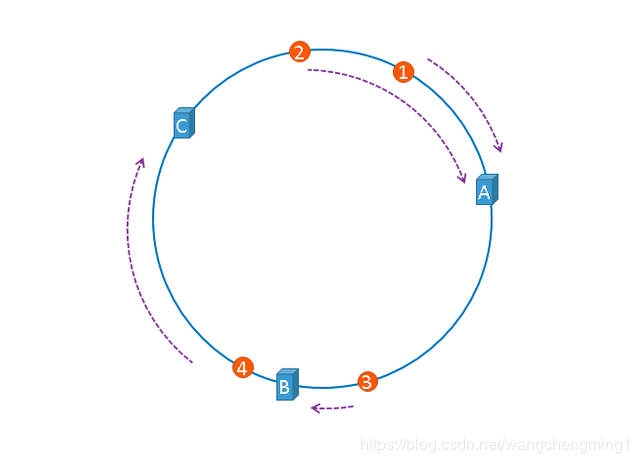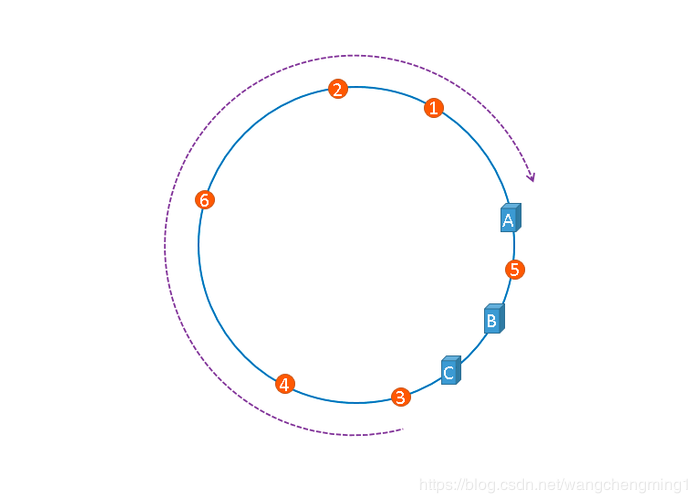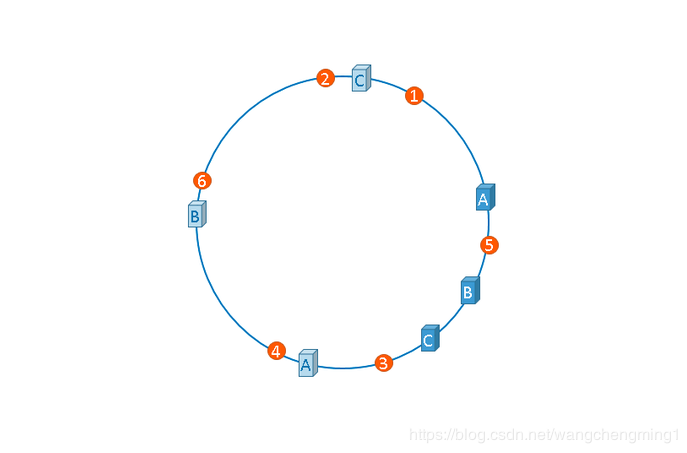dubbo3源码解析----负载均衡算法的实现
负载均衡是开发中的重要模块,以 dubbo3 的源码为例,详细讲解负载均衡算法的实现
目前 Dubbo 内置了如下负载均衡算法,用户可直接配置使用:
| 算法 | 特性 | 备注 |
|---|---|---|
| RandomLoadBalance | 加权随机 | 默认算法,默认权重相同 |
| RoundRobinLoadBalance | 加权轮询 | 借鉴于 Nginx 的平滑加权轮询算法,默认权重相同 |
| LeastActiveLoadBalance | 最少活跃优先 + 加权随机 | 背后是能者多劳的思想 |
| ShortestResponseLoadBalance | 最短响应优先 + 加权随机 | 更加关注响应速度 |
| ConsistentHashLoadBalance | 一致性 Hash | 确定的入参,确定的提供者,适用于有状态请求 |
都继承了AbstractLoadBalance类
AbstractLoadBalance抽象类分析
@SPI(RandomLoadBalance.NAME)
public interface LoadBalance {
/**
* select one invoker in list.
*
* @param invokers invokers.
* @param url refer url
* @param invocation invocation.
* @return selected invoker.
*/
@Adaptive("loadbalance")
<T> Invoker<T> select(List<Invoker<T>> invokers, URL url, Invocation invocation) throws RpcException;
}
public abstract class AbstractLoadBalance implements LoadBalance {
/**
* Calculate the weight according to the uptime proportion of warmup time
* the new weight will be within 1(inclusive) to weight(inclusive)
*
* @param uptime the uptime in milliseconds
* @param warmup the warmup time in milliseconds
* @param weight the weight of an invoker
* @return weight which takes warmup into account
*/
static int calculateWarmupWeight(int uptime, int warmup, int weight) {
// 计算启动时的 比例的 warm 的 Weight
int ww = (int) ( uptime / ((float) warmup / weight));
return ww < 1 ? 1 : (Math.min(ww, weight));
}
@Override
public <T> Invoker<T> select(List<Invoker<T>> invokers, URL url, Invocation invocation) {
if (CollectionUtils.isEmpty(invokers)) {
return null;
}
if (invokers.size() == 1) {
return invokers.get(0);
}
// 调子类的具体实现
return doSelect(invokers, url, invocation);
}
protected abstract <T> Invoker<T> doSelect(List<Invoker<T>> invokers, URL url, Invocation invocation);
/**
* Get the weight of the invoker's invocation which takes warmup time into account
* if the uptime is within the warmup time, the weight will be reduce proportionally
*
* @param invoker the invoker
* @param invocation the invocation of this invoker
* @return weight
*/
protected int getWeight(Invoker<?> invoker, Invocation invocation) {
int weight;
URL url = invoker.getUrl();
if (invoker instanceof ClusterInvoker) {
url = ((ClusterInvoker<?>) invoker).getRegistryUrl();
}
// Multiple registry scenario, load balance among multiple registries.
// 多注册表场景,多个注册表之间的负载平衡。
if (REGISTRY_SERVICE_REFERENCE_PATH.equals(url.getServiceInterface())) {
// 判断当前的服务接口是否为注册中心服务引用的服务接口
// 直接返回 weight
weight = url.getParameter(WEIGHT_KEY, DEFAULT_WEIGHT);
} else {
// 是在热启动中的服务
weight = url.getMethodParameter(invocation.getMethodName(), WEIGHT_KEY, DEFAULT_WEIGHT);
if (weight > 0) {
long timestamp = invoker.getUrl().getParameter(TIMESTAMP_KEY, 0L);
if (timestamp > 0L) {
long uptime = System.currentTimeMillis() - timestamp;
if (uptime < 0) {
return 1;
}
int warmup = invoker.getUrl().getParameter(WARMUP_KEY, DEFAULT_WARMUP);
if (uptime > 0 && uptime < warmup) {
// 根据启动时间的比例 计算一个WarmupWeight
weight = calculateWarmupWeight((int)uptime, warmup, weight);
}
}
}
}
return Math.max(weight, 0);
}
}
RandomLoadBalance
- 加权随机算法的思路
比如我们有四台服务器,分别是A,B,C,D服务器。对应的权重分别是10,20,30,40。现在把这些权重值平铺在一维坐标值上,如下图所示
+-----------------------------------------------------------------------------------+
| | | | |
+-----------------------------------------------------------------------------------+
1 10 30 60 100
|-----A----|-------B-------|-----------C-----------|---------------D--------------|
-------------------15
---------------------------------37
--------------------------------------------------------------74
上面的图中一共有4块区域,长度分别是A,B,C和D的权重。然后从100个数中随机选择一个。然后再判断该数分布在哪个区域。比如,如果随机到37,37是分布在C区域的,那么就选择 Invoker C。15是在B区域,74是在D区域。
- 执行次数越多,分布越均匀
public class RandomLoadBalance extends AbstractLoadBalance {
// @SPI用
public static final String NAME = "random";
@Override
protected <T> Invoker<T> doSelect(List<Invoker<T>> invokers, URL url, Invocation invocation) {
// invoker的数量
int length = invokers.size();
// 每个invoker的权重相同
boolean sameWeight = true;
// 每个invoker的权重的数组
int[] weights = new int[length];
// 第一个invoker的权重
int firstWeight = getWeight(invokers.get(0), invocation);
weights[0] = firstWeight;
// 所有invoker的权重之和
int totalWeight = firstWeight;
for (int i = 1; i < length; i++) {
int weight = getWeight(invokers.get(i), invocation);
// 保存以待后用
weights[i] = weight;
// 计算所有invoker的权重之和
totalWeight += weight;
if (sameWeight && weight != firstWeight) {
sameWeight = false;
}
}
// 如果并非所有invoker都具有相同的权重,并且至少有一个invoker的权重大于0,根据totalWeight进行选择
if (totalWeight > 0 && !sameWeight) {
// 根据总权重随机出一个偏移量
int offset = ThreadLocalRandom.current().nextInt(totalWeight);
// 根据随机值返回invoker
for (int i = 0; i < length; i++) {
offset -= weights[i];
if (offset < 0) {
return invokers.get(i);
}
}
}
// 如果所有invoker都具有相同的权重值或totalWeight = 0,则平均返回。
return invokers.get(ThreadLocalRandom.current().nextInt(length));
}
}
RoundRobinLoadBalance
权重轮询负载均衡算法会根据设置的权重来判断轮循的比例。权重轮循分为普通权重轮询和平滑权重轮询。普通权重轮询会造成某个节点会被频繁选中,容易导致一个节点的流量在短时间内增加很多。平滑权重轮询会在轮询时会穿插选择其他的节点,让整个服务器的选择过程比较均匀,不会导致一个节点的流量暴增。
- 加权轮询的定义:
但现实情况下,我们并不能保证每台服务器性能均相近。如果我们将等量的请求分配给性能较差的服务器,这显然是不合理的。因此,这个时候我们需要对轮询过程进行加权,以调控每台服务器的负载。经过加权后,每台服务器能够得到的请求数比例,接近或等于他们的权重比。比如服务器 A、B、C 权重比为 5:2:1。那么在8次请求中,服务器 A 将收到其中的5次请求,服务器 B 会收到其中的2次请求,服务器 C 则收到其中的1次请求。
public class RoundRobinLoadBalance extends AbstractLoadBalance {
public static final String NAME = "roundrobin";
private static final int RECYCLE_PERIOD = 60000;
// 内置类 => 封装WeightedRoundRobin
protected static class WeightedRoundRobin {
// invoker的权重值
private int weight;
// 考虑到并发场景下某个invoker会被同时选中,所以计算被所有线程选中的权重总和
private AtomicLong current = new AtomicLong(0);
// 最后一次更新时间
private long lastUpdate;
public int getWeight() {
return weight;
}
public void setWeight(int weight) {
this.weight = weight;
current.set(0);
}
public long increaseCurrent() {
// 原子在每次调用计算当前权重
return current.addAndGet(weight);
}
public void sel(int total) {
current.addAndGet(-1 * total);
}
public long getLastUpdate() {
return lastUpdate;
}
public void setLastUpdate(long lastUpdate) {
this.lastUpdate = lastUpdate;
}
}
private ConcurrentMap<String, ConcurrentMap<String, WeightedRoundRobin>> methodWeightMap = new ConcurrentHashMap<String, ConcurrentMap<String, WeightedRoundRobin>>();
/**
* get invoker addr list cached for specified invocation
* 当前 invoker 的 轮询 addr list
* <p>
* <b>for unit test only</b>
*
* @param invokers
* @param invocation
* @return
*/
protected <T> Collection<String> getInvokerAddrList(List<Invoker<T>> invokers, Invocation invocation) {
String key = invokers.get(0).getUrl().getServiceKey() + "." + invocation.getMethodName();
Map<String, WeightedRoundRobin> map = methodWeightMap.get(key);
if (map != null) {
return map.keySet();
}
return null;
}
@Override
protected <T> Invoker<T> doSelect(List<Invoker<T>> invokers, URL url, Invocation invocation) {
// 远程调的 method key
String key = invokers.get(0).getUrl().getServiceKey() + "." + invocation.getMethodName();
// 获取 url 到 WeightedRoundRobin 映射表 没有 初始化 ConcurrentHashMap
ConcurrentMap<String, WeightedRoundRobin> map = methodWeightMap.computeIfAbsent(key, k -> new ConcurrentHashMap<>());
int totalWeight = 0;
long maxCurrent = Long.MIN_VALUE;
long now = System.currentTimeMillis();
Invoker<T> selectedInvoker = null;
WeightedRoundRobin selectedWRR = null;
// 遍历 Invoker 列表
for (Invoker<T> invoker : invokers) {
String identifyString = invoker.getUrl().toIdentityString();
// 获取 服务实例的 weight => 系统设置 或 默认 或根据启动时间热身的比例 weight
int weight = getWeight(invoker, invocation);
// 获取weightedRoundRobin 没有对应的就根据获得 weight 设置new weightedRoundRobin
WeightedRoundRobin weightedRoundRobin = map.computeIfAbsent(identifyString, k -> {
WeightedRoundRobin wrr = new WeightedRoundRobin();
wrr.setWeight(weight);
return wrr;
});
// 检测 Invoker 权重是否发生了变化,若变化了,则更新 WeightedRoundRobin 的 weight 字段
if (weight != weightedRoundRobin.getWeight()) {
//weight changed
weightedRoundRobin.setWeight(weight);
}
// identifyString 对应的 weightedRoundRobin 增加 weight
// 让 current 字段加上自身权重,等价于 current += weight
long cur = weightedRoundRobin.increaseCurrent();
// 设置 lastUpdate 字段,即 lastUpdate = now
weightedRoundRobin.setLastUpdate(now);
// 寻找具有最大 current 的 Invoker,以及 Invoker 对应的 WeightedRoundRobin,
// 暂存起来,留作后用
if (cur > maxCurrent) {
// 替换 最大权重的 selectedInvoker
maxCurrent = cur;
selectedInvoker = invoker;
selectedWRR = weightedRoundRobin;
}
// 计算权重总和
totalWeight += weight;
}
if (invokers.size() != map.size()) {
// 若WeightedRoundRobin未更新时长超过阈值后,就会被map移除掉,默认阈值为60秒。
map.entrySet().removeIf(item -> now - item.getValue().getLastUpdate() > RECYCLE_PERIOD);
}
if (selectedInvoker != null) {
// 让 current 减去权重总和
selectedWRR.sel(totalWeight);
// 返回 具有最大 current 的 选到的selectedInvoker
return selectedInvoker;
}
// should not happen here
return invokers.get(0);
}
}
- 下一次轮询的时候 会从已经维护好的methodWeightMap中直接取出对应的weightedRoundRobin,基于前一轮的维护过的 weight 再次自增,选出最大的 current 再减一次权重总和, 实现了平滑加权轮询算法
可以 用 5 2 1 模拟几次加权计算的算法,就能明白算法逻辑
(5) 2 1 => -3 2 1=>2 (4) 2 => 2 -4 2 => (7 ) -2 3 => -1 -2 3 => (4) 0 4 => -4 0 4 => 1 2 (5) => …
LeastActiveLoadBalance
最少活跃调用数算法的思想就是"活跃调用数越少,证明服务效率越高,单位时间内可以处理的请求就越多"。每一个服务提供者对应一个active,初始值都是0,每增加一次请求就+1,每完成一次请求就-1。在服务运行一段时间之后,性能越好的服务的active就越小,处理请求的速度就越快,所以获得新请求的机会就越大,这就是最少活跃数负载均衡算法的基本思想。
LeastActiveLoadBalance在最少活跃数负载均衡算法的基础上增加权重的概念。举个例子来说明:有两个性能非常好的服务器,在某一时间active是相同的,此时 Dubbo 会根据它们的权重去分配请求,权重越大,获取到新请求的概率就越大。如果两个服务提供者权重相同,此时随机选择一个即可。
- 算法理解: 节点的活跃数维护在RpcStatus内, active 的值是维护在调用前后增减
①遍历 invokers 列表,寻找活跃数最小的Invok
②如果有多个Invoker具有相同的最小活跃数,此时记录下这些Invoker在invokers 集合中的下标,并累加它们的权重,比较它们的权重值是否相等。=> 用于加权随机选择节点
③如果只有一个Invoker具有最小的活跃数,此时直接返回该Invoker即可
④如果有多个Invoker具有最小活跃数,且它们的权重不相等 => RandomLoadBalance 一致。
⑤如果有多个Invoker具有最小活跃数,但它们的权重相等,此时随机返回一个即可。
public class RpcStatus {
private static final ConcurrentMap<String, RpcStatus> SERVICE_STATISTICS = new ConcurrentHashMap<String,
RpcStatus>();
private static final ConcurrentMap<String, ConcurrentMap<String, RpcStatus>> METHOD_STATISTICS =
new ConcurrentHashMap<String, ConcurrentMap<String, RpcStatus>>();
private final ConcurrentMap<String, Object> values = new ConcurrentHashMap<String, Object>();
private final AtomicInteger active = new AtomicInteger();
private final AtomicLong total = new AtomicLong();
private final AtomicInteger failed = new AtomicInteger();
private final AtomicLong totalElapsed = new AtomicLong();
private final AtomicLong failedElapsed = new AtomicLong();
private final AtomicLong maxElapsed = new AtomicLong();
private final AtomicLong failedMaxElapsed = new AtomicLong();
private final AtomicLong succeededMaxElapsed = new AtomicLong();
....
}
public class LeastActiveLoadBalance extends AbstractLoadBalance {
public static final String NAME = "leastactive";
@Override
protected <T> Invoker<T> doSelect(List<Invoker<T>> invokers, URL url, Invocation invocation) {
// invoker的数量
int length = invokers.size();
// 所有invoker的最小活跃数
int leastActive = -1;
// 具有相同“最小活跃数”的服务者提供者
int leastCount = 0;
// 记录具有相同“最小活跃数”的 Invoker 在 invokers 列表中的下标信息
int[] leastIndexes = new int[length];
// 每一个invoker的权重
int[] weights = new int[length];
// 所有invoker的权重之和
int totalWeight = 0;
// 第一个最小活跃数的 Invoker 权重值,用于与其他具有相同最小活跃数的 Invoker 的权重进行对比,
int firstWeight = 0;
// 以检测是否“所有具有相同最小活跃数的 Invoker 的权重”均相等
boolean sameWeight = true;
// 开始遍历所有invokers
for (int i = 0; i < length; i++) {
Invoker<T> invoker = invokers.get(i);
// 获取当前索引的invoker的活跃数
int active = RpcStatus.getStatus(invoker.getUrl(), invocation.getMethodName()).getActive();
// 获取权重,默认是100
int afterWarmup = getWeight(invoker, invocation);
// 保存后面使用
weights[i] = afterWarmup;
// 如果是第一个invoker,或者当前invoker的active小于最小活跃数
if (leastActive == -1 || active < leastActive) {
// 将当前invoker的active赋值给最小活跃数
leastActive = active;
// 更新leastCount为1
leastCount = 1;
// 记录当前下标值到 leastIndexs 中
leastIndexes[0] = i;
// 重置 totalWeight
totalWeight = afterWarmup;
// 记录第一个最小活跃数的 invoker 权重值
firstWeight = afterWarmup;
// 每一个invoker都有相同的权重(这里只有一个调用)
sameWeight = true;
// 如果当前invoker的active等于最小活跃数,则累加
} else if (active == leastActive) {
// 在 leastIndexs 中记录下当前 Invoker 在 invokers 集合中的下标
leastIndexes[leastCount++] = i;
// 累加权重
totalWeight += afterWarmup;
// 检测当前 Invoker 的权重与 firstWeight 是否相等,不相等则将 sameWeight 置为 false
if (sameWeight && afterWarmup != firstWeight) {
sameWeight = false;
}
}
}
// 当只有一个 Invoker 具有最小活跃数,此时直接返回该 Invoker 即可
if (leastCount == 1) {
return invokers.get(leastIndexes[0]);
}
// 有多个 invoker 具有相同的最小活跃数,但它们之间的权重不同
if (!sameWeight && totalWeight > 0) {
// 生成一个随机数
int offsetWeight = ThreadLocalRandom.current().nextInt(totalWeight);
// 循环让随机数减去具有最小活跃数的 Invoker 的权重值,
// 当 offset 小于等于0时,返回相应的 Invoker
for (int i = 0; i < leastCount; i++) {
int leastIndex = leastIndexes[i];
// 获取权重值,并让随机数减去权重值
// 计算随机值在哪两个个节点的权重值之间
offsetWeight -= weights[leastIndex];
if (offsetWeight < 0) {
return invokers.get(leastIndex);
}
}
}
// 如果权重相同或权重为0时,随机返回一个 Invoker
return invokers.get(leastIndexes[ThreadLocalRandom.current().nextInt(leastCount)]);
}
}
ConsistentHashLoadBalance
算法设计的目的:
一致性 Hash,相同参数的请求总是发到同一提供者。当某一台提供者挂时,原本发往该提供者的请求,基于虚拟节点,平摊到其它提供者,不会引起剧烈变动。
- 缺省只对第一个参数Hash,如果要修改,请配置 <dubbo:parameter key=“hash.arguments” value=“0,1” />
- 缺省用 160 份虚拟节点,如果要修改,请配置 <dubbo:parameter key=“hash.nodes” value=“320” />
Hash算法的定义
把任意长度的输入,通过Hash算法变换成固定长度的输出,这个输出就是Hash值。哈希值的空间远小于输入的空间,所以可能会发生“哈希碰撞”,即两个不同的输入,产生了同一个输出。
Hash算法只是一个定义,并没有规定具体的实现。比如我们常见的MD5、SHA都属于Hash算法的实现。
一致性Hash算法的定义
使用一致性Hash可以解决因为横向伸缩导致的大规模数据变动。
先对服务器节点的IP进行Hash,然后取模得到服务器节点在这个Hash环中的位置,然后并将这个Hash投射到 [0, 2^32 - 1] 的圆环上。

假设这个时候来了一个请求,先对这个请求进行Hash求值,然后取模求余,然后顺时针找到第一个节点,那么这个节点就是负责处理请求的节点。比如请求①和②就是节点A负责处理,③就是节点B负责处理,④就是节点C负责处理。

但是一致性Hash也存在一定的局限性。假如节点很少的情况下,一致性Hash就会出现分布不均匀的情况。如下所示,①②③④⑥的请求都会落在A节点上,这个时候就会对A节点增加过多的符合。

那么这个时候提出了虚拟节点的概念,通过虚拟节点均衡各个节点的请求量。所谓虚拟节点,就是除了对服务本身地址进行Hash映射外,还通过在它地址上做些处理(比如Dubbo中,在ip+port的字符串后加上计数符1、2、3…,分别代表虚拟节点1、2、3),以达到同一服务映射多个节点的目的。

算法理解
粗暴的理解
-
对 ip 地址 hash算法 出多个虚拟节点的 int值,作为 key 插入到一个 hashMap 中, 值为 ip 节点;
- 不同权重的节点可以增加不同数量的虚拟节点
-
再保存一个 ip 地址为key 的 hashMap,存储期 hashKey => 环调整时即主要调整这两个 map 的映射关系
- 取决于是否需要维护这层关系
-
取节点时,在随机一个int 值,在 hashMap 的 key 中找到第一个大于它的虚拟节点值,找到其 ip 节点
代码分析
- 重点在于怎么构建一致性 hash 环
/**
* ConsistentHashLoadBalance
*/
public class ConsistentHashLoadBalance extends AbstractLoadBalance {
public static final String NAME = "consistenthash";
/**
* Hash nodes name
*/
public static final String HASH_NODES = "hash.nodes";
/**
* Hash arguments name
*/
public static final String HASH_ARGUMENTS = "hash.arguments";
private final ConcurrentMap<String, ConsistentHashSelector<?>> selectors = new ConcurrentHashMap<String, ConsistentHashSelector<?>>();
@SuppressWarnings("unchecked")
@Override
protected <T> Invoker<T> doSelect(List<Invoker<T>> invokers, URL url, Invocation invocation) {
String methodName = RpcUtils.getMethodName(invocation);
String key = invokers.get(0).getUrl().getServiceKey() + "." + methodName;
// using the hashcode of list to compute the hash only pay attention to the elements in the list
int invokersHashCode = invokers.hashCode();
// 获取当前 key 对应的 一致性 hash 环选择器
ConsistentHashSelector<T> selector = (ConsistentHashSelector<T>) selectors.get(key);
if (selector == null || selector.identityHashCode != invokersHashCode) {
// 当selector 或者 selector的标志 hashcode 不等于 invokersHashCode时
// 重新构建一致性 hash 环选择器,并放回selectors中
selectors.put(key, new ConsistentHashSelector<T>(invokers, methodName, invokersHashCode));
selector = (ConsistentHashSelector<T>) selectors.get(key);
}
// 从 一致性 hash 环选择器 选择节点
return selector.select(invocation);
}
private static final class ConsistentHashSelector<T> {
private final TreeMap<Long, Invoker<T>> virtualInvokers;
private final int replicaNumber;
private final int identityHashCode;
private final int[] argumentIndex;
ConsistentHashSelector(List<Invoker<T>> invokers, String methodName, int identityHashCode) {
// 一致性 hash 环 TreeMap
this.virtualInvokers = new TreeMap<Long, Invoker<T>>();
this.identityHashCode = identityHashCode;
URL url = invokers.get(0).getUrl();
// 虚拟节点总数
this.replicaNumber = url.getMethodParameter(methodName, HASH_NODES, 160);
// 读取配置的 要进入 key -- hash 计算的参数个数
String[] index = COMMA_SPLIT_PATTERN.split(url.getMethodParameter(methodName, HASH_ARGUMENTS, "0"));
argumentIndex = new int[index.length];
for (int i = 0; i < index.length; i++) {
argumentIndex[i] = Integer.parseInt(index[i]);
}
for (Invoker<T> invoker : invokers) {
String address = invoker.getUrl().getAddress();
for (int i = 0; i < replicaNumber / 4; i++) {
// 对每个节点 计算 digest
byte[] digest = Bytes.getMD5(address + i);
for (int h = 0; h < 4; h++) {
// 根据digest 和 h 计算虚拟节点值
long m = hash(digest, h);
// 放入 环中
virtualInvokers.put(m, invoker);
}
}
}
}
public Invoker<T> select(Invocation invocation) {
// 用参数计算一个取环节点的 hash 值
String key = toKey(invocation.getArguments());
byte[] digest = Bytes.getMD5(key);
return selectForKey(hash(digest, 0));
}
private String toKey(Object[] args) {
// 拼接参数到 str
StringBuilder buf = new StringBuilder();
for (int i : argumentIndex) {
if (i >= 0 && i < args.length) {
buf.append(args[i]);
}
}
return buf.toString();
}
private Invoker<T> selectForKey(long hash) {
// 用 hash 值取出一个 entry 返回
// ceilingEntry : 在树中找第一个大于它的节点
Map.Entry<Long, Invoker<T>> entry = virtualInvokers.ceilingEntry(hash);
if (entry == null) {
entry = virtualInvokers.firstEntry();
}
return entry.getValue();
}
// 一串位运算
private long hash(byte[] digest, int number) {
return (((long) (digest[3 + number * 4] & 0xFF) << 24)
| ((long) (digest[2 + number * 4] & 0xFF) << 16)
| ((long) (digest[1 + number * 4] & 0xFF) << 8)
| (digest[number * 4] & 0xFF))
& 0xFFFFFFFFL;
}
}
}
// 树中查找的操作
final Entry<K,V> getCeilingEntry(K key) {
Entry<K,V> p = root;
while (p != null) {
int cmp = compare(key, p.key);
if (cmp < 0) {
if (p.left != null)
p = p.left;
else
return p;
} else if (cmp > 0) {
if (p.right != null) {
p = p.right;
} else {
Entry<K,V> parent = p.parent;
Entry<K,V> ch = p;
while (parent != null && ch == parent.right) {
ch = parent;
parent = parent.parent;
}
return parent;
}
} else
return p;
}
return null;
}
参考链接:
Dubbo进阶(十二):负载均衡 https://juejin.cn/post/6844904192788660232




 本文以dubbo3源码为例,详细讲解负载均衡算法的实现。介绍了Dubbo内置的多种负载均衡算法,包括RandomLoadBalance、RoundRobinLoadBalance、LeastActiveLoadBalance和ConsistentHashLoadBalance,分析了各算法的思路、特点及代码实现,还提及一致性Hash算法的设计目的、定义和局限性。
本文以dubbo3源码为例,详细讲解负载均衡算法的实现。介绍了Dubbo内置的多种负载均衡算法,包括RandomLoadBalance、RoundRobinLoadBalance、LeastActiveLoadBalance和ConsistentHashLoadBalance,分析了各算法的思路、特点及代码实现,还提及一致性Hash算法的设计目的、定义和局限性。

















 被折叠的 条评论
为什么被折叠?
被折叠的 条评论
为什么被折叠?








